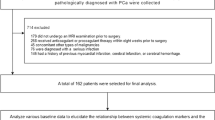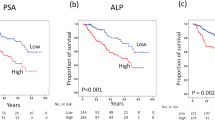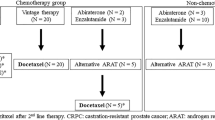Abstract
Background:
Hyperfibrinogen is thought to be associated with a higher risk of invasion and metastasis, as well as a worse outcome for multiple types of cancer. However, the prognostic significance of plasma fibrinogen has not been investigated in prostate cancer with hormonal therapy. The objective of this study was to evaluate its roles in prostate cancer patients treated with androgen deprivation therapy (ADT).
Methods:
A total of 290 patients who underwent ADT as first-line therapy for prostate cancer were retrospectively analyzed. The fibrinogen level was measured at the time of diagnosis. Patients were categorized using a cutoff point of 3.225 g l−1 according to a calculation by the receiver operating curve analysis. Correlations between the fibrinogen and clinical characteristics were analyzed. Meanwhile, univariable and multivariable cox regression analyses were performed to determine the associations of fibrinogen with progression-free survival (PFS), cancer-specific survival (CSS) and overall survival (OS). Prognostic accuracy was evaluated with the Harrell concordance index.
Results:
Compared with patients with a lower fibrinogen level (<3.225 g l−1), patients with a higher fibrinogen level were more likely to have higher PSA, Gleason score, risk stratification and incidence of metastasis (P<0.05). Multivariable analyses identified hyperfibrinogen as an independent prognostic factor for PFS (hazard ratio (HR)=2.000, P<0.001), CSS (HR=2.209, P=0.006) and OS (HR=1.965, P=0.009). The final models built by the addition of fibrinogen improved predictive accuracy (c-index: 0.750, 0.799 and 0.767) for PFS, CSS and OS compared with the clinicopathological base models (c-index: 0.730, 0.778 and 0.746), which included Gleason score and metastasis.
Conclusions:
The pretreatment plasma fibrinogen level was associated with tumor progression and might have a significant role in the prognosis of the prostate cancer patients treated with ADT. Thus, we recommend adding fibrinogen to traditional prognostic model, which may improve its predictive accuracy.
This is a preview of subscription content, access via your institution
Access options
Subscribe to this journal
Receive 4 print issues and online access
$259.00 per year
only $64.75 per issue
Buy this article
- Purchase on Springer Link
- Instant access to full article PDF
Prices may be subject to local taxes which are calculated during checkout




Similar content being viewed by others
References
Siegel R, Miller KD, Jemal A . Cancer statistics, 2015. CA Cancer J Clin 2015; 65: 5–29.
Wein AJ, Kavaussi LR, Novick AC, Partin AW, Peters CA, Nelson JB et al. Campbell-Wash Urology, 10th edn. Elsevier: Philadelphia, 2012, pp 2934–2953.
Tas F, Kilic L, Duranyildiz D . Coagulation tests show significant differences in patients with breast cancer. Tumor Biol 2014; 35: 5985–5992.
Zhou YX, Yang ZM, Feng J, Shan YJ, Wang WL, Mei YQ . High plasma D-dimer level is associated with decreased survival in patients with lung cancer: a meta-analysis. Tumor Biol 2013; 34: 3701–3704.
Wang RT, Zhang LQ, Mu YP, Li JB, Xu XS, Pang Q et al. Prognostic significance of preoperative platelet count in patients with gallbladder cancer. World J Gastroenterol 2015; 21: 5303–5310.
Wang JB, Liu H, Shao N, Tan BX, Song QX, Jia YB et al. The clinical significance of preoperative plasma fibrinogen level and platelet count in resectable esophageal squamous cell carcinoma. World J Surg Oncol 2015; 13: 157.
Pichler M, Hutterer GC, Stojakovic T, Mannweiler S, Pummer K, Zigeuner R . High plasma fibrinogen level represents an independent negative prognostic factor regarding cancer-specific, metastasis-free, as well as overall survival in a European cohort of non-metastatic renal cell carcinoma patients. Br J Cancer 2013; 109: 1123–1129.
Shu YJ, Weng H, Bao RF, Wu XS, Ding Q, Cao Y et al. Clinical and prognostic significance of preoperative plasma hyperfibrinogenemia in gallbladder cancer patients following surgical resection: a retrospective and in vitro study. BMC Cancer 2014; 14: 566.
Pichler M, Dalpiaz O, Ehrlich GC, Stojakovic T, Martín Hernández JM, Mannweiler S et al. Validation of the preoperative plasma fibrinogen level as a prognostic factor in a European cohort of patients with localized upper tract urothelial carcinoma. J Urol 2014; 191: 920–925.
Sun ZQ, Han XN, Wang HJ, Tang Y, Zhao ZL, Qu YL et al. Prognostic significance of preoperative fibrinogen in patients with colon cancer. World J Gastroenterol 2014; 20: 8583–8591.
Kim KH, Park TY, Lee JY, Lee SM, Yim JJ, Yoo CG et al. Prognostic significance of initial platelet counts and fibrinogen level in advanced non-small cell lung cancer. J Korean Med Sci 2014; 29: 507–511.
Ghanim B, Hoda MA, Klikovits T, Winter MP, Alimohammadi A, Grusch M et al. Circulating fibrinogen is a prognostic and predictive biomarker in malignant pleural mesothelioma. Br J Cancer 2014; 110: 984–990.
Thurner EM, Krenn-Pilko S, Langsenlehner U, Stojakovic T, Pichler M, Gerger A et al. The association of an elevated plasma fibrinogen level with cancer-specific and overall survival in prostate cancer patients. World J Urol 2014; 33: 1467–1473.
Ziaran S, Goncalves FM, Breza J Sr . Patients with prostate cancer treated by ADT have significantly higher fibrinogenemia than healthy control. World J Urol 2013; 31: 289–292.
Heidenreich A, Bastian PJ, Bellmunt J, Bolla M, Joniau S, van der Kwast T et al. EAU guidelines on prostate cancer. part 1: screening, diagnosis,and local treatment with curative intent-update 2013. Eur Urol 2014; 65: 124–137.
Heidenreich A, Bastian PJ, Bellmunt J, Bolla M, Joniau S, van der Kwast T et al. EAU guidelines on prostate cancer. part II: treatment of advanced, relapsing, and castration-resistant prostatecancer. Eur Urol 2014; 65: 467–479.
Seal US, Doe RP, Byar DP, Corle DK . Response of plasma fibrinogen and plasminogen to hormone treatment and the relation of pretreatment values to mortality in patients with prostatic cancer. Cancer 1976; 38: 1108–1117.
McDonald AC, Vira MA, Vidal AC, Gan W, Freedland SJ, Taioli E . Association between systemic inflammatory markers and serum prostate-specific antigen in men without prostatic disease – the 2001-2008 National Health and Nutrition Examination Survey. Prostate 2014; 74: 561–567.
Yano HJ, Hatano K, Tsuno N, Osada T, Watanabe T, Tsuruo T et al. Clustered cancer cells show a distinct adhesion behavior from single cell form under physiological shear conditions. J Exp Clin Cancer Res 2001; 20: 407–412.
Sahni A, Francis CW . Vascular endothelial growth factor binds to fibrinogen and fibrin and stimulates endothelial cell proliferation. Blood 2000; 96: 3772–3778.
Sahni A, Simpson-Haidaris PJ, Sahni SK, Vaday GG, Francis CW . Fibrinogen synthesized by cancer cells augments the proliferative effect of fibroblast growth factor-2 (FGF-2). J Thrombosis Haemostasis 2008; 6: 176–183.
Zheng S, Shen J, Jiao Y, Liu Y, Zhang C, Wei M et al. Platelets and fibrinogen facilitate each other in protecting tumor cells from natural killer cytotoxicity. Cancer Sci 2009; 100: 859–865.
Steinbrecher KA, Horowitz NA, Blevins EA, Barney KA, Shaw MA, Harmel-Laws E et al. Colitis-associated cancer is dependent on the interplay between the hemostatic and inflammatory systems and supported by integrin alpha(M)beta(2) engagement of fibrinogen. Cancer Res 2010; 70: 2634–2643.
Acknowledgements
This study was supported by National Natural Science Foundation of China (91129725,81572536), Science and Technology Commission of Shanghai Municipality (14140901700), Shanghai Municipal Education Commission(15ZZ058), and Key Disciplines Group Construction Project of Pudong Health Bureau of Shanghai (PWZxq2014-05).
Author information
Authors and Affiliations
Corresponding authors
Ethics declarations
Competing interests
The authors declare no conflict of interest.
Rights and permissions
About this article
Cite this article
Wang, Y., Yin, W., Wang, Z. et al. Pretreatment plasma fibrinogen as an independent prognostic indicator of prostate cancer patients treated with androgen deprivation therapy. Prostate Cancer Prostatic Dis 19, 209–215 (2016). https://doi.org/10.1038/pcan.2016.6
Received:
Revised:
Accepted:
Published:
Issue Date:
DOI: https://doi.org/10.1038/pcan.2016.6
This article is cited by
-
Pretreatment elevated prognostic nutritional index predicts a favorable prognosis in patients with prostate cancer
BMC Cancer (2020)
-
Prostate cancer and prostatic diseases Best of China, 2018
Prostate Cancer and Prostatic Diseases (2019)
-
Systemic immune-inflammation index, serum albumin, and fibrinogen impact prognosis in castration-resistant prostate cancer patients treated with first-line docetaxel
International Urology and Nephrology (2019)



